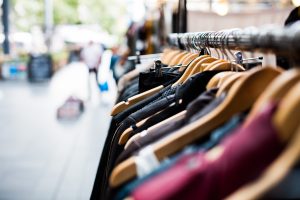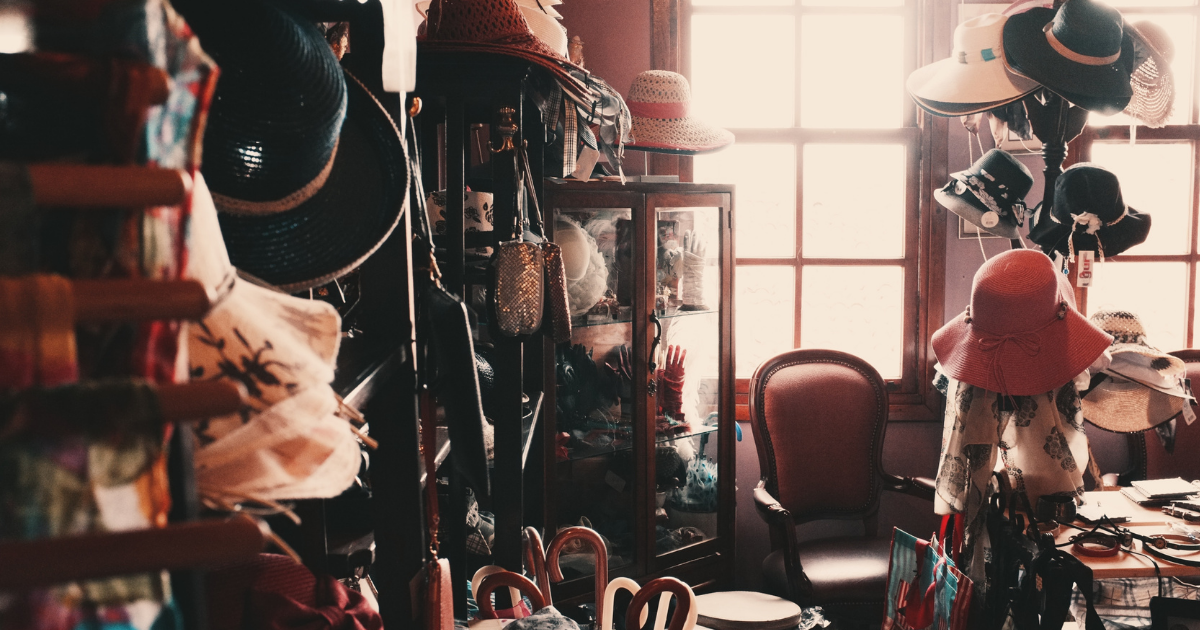Ich bin die jüngste von drei Mädchen, was das mit Secondhand oder sogar mit Nachhaltigkeit zu tun hat? Bei Familien wo das Geld nicht so locker sitzt, und so war es bei uns, muss man eben Haushalten – mit allen Ressourcen, die einem zur Verfügung stehen. Eben auch mit der Kleidung der Kinder, die zwar noch gut war, aus der die Großen aber schon rausgewachsen waren. Meist hat meine Mutter darauf geachtet, dass die Kleidung immer an das nächste Kind weitergegeben wurde. Mit Anziehsachen wurde damals sehr pfleglich umgegangen, eine von vielen Verhaltensweisen, die ich bis heute aus meiner Erziehung übernommen habe und noch immer lebe. Das bedeutete, dass meine Kleidung schon von zwei Schwestern vor mir getragen wurde – ein Horror ab einem bestimmten Alter – was rückblickend aber richtig und gut war. So habe ich gelernt Werte zu schätzen. Das war unsere Art des Secondhands und der Weitergabe von Kleidung, die einem nicht mehr passte. 
Secondhand ist aber nicht eine Erfindung von Großfamilien. Der Begriff wurde schon Mitte des 15. Jahrhunderts in England genutzt und bezeichnet die Weitergabe von Dingen – von einer Hand in die andere.
Frankreich und Belgien sind wohl als die Ursprungsländer für den An- und Verkauf von Secondhand-Artikeln anzusehen: Dort sollen ab circa 1880 Flohmärkte veranstaltet worden sein, bei denen gebrauchte Kleidung und Gegenstände von der ersten in die zweite Hand wechselten. Der erste Flohmarkt in Deutschland fand dagegen vergleichsweise spät statt: 1967 veranstaltete der Aktionskünstler Reinhard Schamuhn in der Altstadt Hannovers einen Flohmarkt. Bis heute ist dies eine beliebte Plattform für einen Besitzerwechsel verschiedenster Dinge, obwohl es mittlerweile selbstverständlich auch Secondhand-Läden oder Secondhand Onlineshops gibt.
Aber was zeichnet Secondhand aus und wo ist hier die Nachhaltigkeit zu sehen? Führen wir uns mal vor Augen, welche Mittel für die Produktion einer Jeans benötigt werden.
Färben, waschen, wieder färben, schneidern und wieder waschen. Chemikalien, die für die Produktion einer Jeans benötigt werden, können gesundheitsgefährdend sein und müssen deshalb vor dem Verkauf der Waren, ja meist schon vor Ausfuhr aus dem Produktionsland, herausgewaschen werden. Rund 8.000 Liter Wasser werden verbraucht für die Produktion einer ganz normalen Jeans. Da die Jeans nicht gerade ums Eck produziert wird, ist die handelsübliche Jeans schon ein Weltenbummler:
- Baumwolle aus Kasachstan
- Weberei und somit die Herstellung des Jeansstoffes in der Türkei
- Die Garne für die Nähte werden in Taiwan gesponnen
- In Polen wird meist die Indigofarbe (blau) zum Einfärben der Jeansstoffe produziert
- Tunesien ist das Land der Färber
- Eine Veredelung der Stoffe wie z.B. weicher, knitterarm oder ähnlichem, kann in Bulgarien realisiert werden
- Und in China wird aus all dem eine Jeans, die wir hier in Europa gerne kaufen
- In Europa werden diese Jeans meist auch noch für die optimale Präsentation beim Kunden ordentlich gebügelt und an die Endkunden hängend verladen.
An die 60.000 Kilometer hat sie hinter sich, bevor sie dann bei uns in den Läden ankommt. Umweltfreundlich ist das auf jeden Fall nicht. Und wenn sie nur nach wenigen Jahren wieder weggeschmissen wird, dann ist es alles andere als nachhaltig.

Das allgegenwärtige und brisante Thema der Nachhaltigkeit lässt auch die Modebranche nicht unberührt. Es steht die Frage im Raum, warum gerade Secondhand Mode so nachhaltig ist. Die Antwort liegt auf der Hand: Gebrauchtwaren sind bereits unzählige vorhanden. Ergo müssen sie auch nicht mehr produziert werden. So belastet Secondhand Kleidung die Natur noch weniger als es fair hergestellte Mode durch die Verwendung natürlicher und umweltfreundlicher Materialien überhaupt gelingen kann.
Fazit: Kauft man Mode aus zweiter Hand, wird weder die Produktion angekurbelt, noch werden neue Rohstoffe benötigt, geschweige denn Umweltgifte verwendet. Der bestehende Verschleiß wird verlangsamt und die Belastung von Mensch und Umwelt gesenkt. Zalando, einer der größten Modeonline Händler springt gerade auf den Secondhand Zug auf und ist mit seiner zalando wardrobe am Markt aktiv. In der wardrobe werden Lieblingsstücke vom Endkunden wieder an Zalando verkauft. Es wäre doch schön, wenn sich dieses Geschäftsmodell bewährt. Ich bin gespannt, wer noch am Gleis steht und auf diesen Zug aufspringen wird.
Eigentlich ist Secondhand Kleidung ein Paradebeispiel für eine gelungene Form der Nachhaltigkeit. Aber was ist, wenn man den Gedanken, dass jemand anderes schon einmal diese Jacke, Hose oder Bluse getragen hat, einfach nicht mit seinem persönlichen Wohlbefinden vereinbaren kann, man aber zeitgleich Ressourcen und den Geldbeutel schonen möchte? Zum einem kann man schneidern lernen. Ja, das ist kein Scherz. Es gibt viele Schulen und auch Stofflädchen, wo man das Schneidern für private Zwecke erlernen kann und somit das Heimschneidern wiederaufleben lässt. Und genau so kann man dieses Handwerk für sich anwenden und die Bluse, die nicht mehr so hipp ist, einfach wieder aufpeppen. Es gibt mittlerweile viele Tutorials zu dem sogenannte Upcyling in dem viele Anregungen zu finden sind.
Es gibt gute Gründe für Secondhand:
- Secondhand ist ein deutliches Statement gegen die heutige Wegwerfgesellschaft.
- Secondhand, gerade Mode, ist etwas für Individualisten. In Zeiten wachsender modischer Filial-Konformität liefert gebrauchte Kleidung aus zweiter Hand immer auch die Chance auf etwas Eigenständigkeit beim Outfit.
- Secondhand spart bares Geld. Denn gebraucht ist – trotz zahlreicher Billigproduktionen am Mark- in der Regel günstiger als Neuware.
- Vor allem bei Kinderkleidung lässt sich bares Geld mit Secondhand sparen. Gerade, wenn es mehrere Kinder einzukleiden gilt. Dabei ist gebraucht in diesem Bereich keineswegs mit schlechter Qualität gleichzusetzen. Kinder wachsen relativ schnell aus ihren Kleidungsstücken heraus und dementsprechend sind Secondhand-Stücke oft kaum getragen bzw. in fast neuwertigem Zustand. Auch der gesundheitliche Vorteil gegenüber der Neuware ist nicht von der Hand zu weisen, da diese sicherlich schon mehrfach gewaschen wurde. Das häufigere Waschen sorgt für deutlich weniger Chemikalien in den Fasern als bei Neuware.
- Secondhand ist ein aktiver Beitrag zum Umweltschutz. Verpackungen und Müll fallen nicht an, denn für Secondhand werden weder neue Verpackung noch neues Fasermaterial produziert.
Darüber hinaus reduziert sich die Masse an zu entsorgenden Artikeln. Viele Verbraucher wissen nicht, dass z.B. Alttextilien in vielen Fällen einfach verbrannt werden und somit hochgiftige Gase produzieren, die in die Atmosphäre gelangen. Die Rückstände der verbrannten Kleidung stellen eine zusätzliche bzw. nicht gerade geringe Belastung der Umwelt dar.

Letztlich muss aber jeder für sich entscheiden, was für einen selbst das Beste ist und wie man sein Handeln vor sich selbst vertreten kann. Ich persönlich mag eine Mischung von beidem. Ich mag neues als auch altes. Mode ist ja keine Naturgewalt, der man unterworfen ist. Sie entsteht in den Köpfen von kreativen Menschen. Daher gehe ich nicht mit jedem Trend, sondern suche vor allem das, was mir gefällt. Und ich gebe meine Kleidung aus der ich „rausgewachsen“ bin, gerne in meinem Freundes- und Bekanntenkreis weiter.
Der 25. August ist übrigens der Tag der gebrauchten Kleidung, wussten Sie das?
Secondhand kann für den einen Altkleider oder Gerümpel sein, aber für den anderen ist es eine Inspiration.
Ein wärmendes oder dringend benötigtes Kleidungsstück oder Mobiliar oder Einrichtungsgegenstand, den man schon lange, genauso, gesucht hat.
Dieser Artikel wurde stellvertretend für Setlog von Simone Göbelshagen geschrieben
